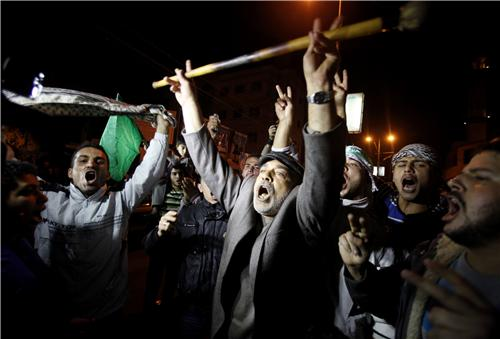Gaza Celebrates Cease-Fire Like A Military Victory

GAZA CITY, Gaza Strip -- The Gaza Strip came back to life on Thursday after eight days of heavy shelling by Israeli forces, while Palestinian militias fired hundreds of rockets at Israel.
The truce, negotiated by Egypt and the United States, came as a godsend for many here who had spent the weeklong war cooped up at home, not daring to leave for fear of shelling and aerial attacks.
“I had been dealing with power cuts and got the news of the cease-fire only when I asked a neighbor about the shots I heard outside,” said Nivin, a resident of Khan Younis, a city in the southern part of the Gaza Strip, who would give only his first name.
It was people firing their weapons into the air to celebrate the agreement, which Gaza's governing party, Hamas, and the Islamic Jihad have been calling a victory.
If the cessation of violence and reopening of shops is a victory, then they are right. Streets were filled by honking cars carrying the Hamas green flag, the Palestinian flag and even the yellow banner of Al Fatah, the party led by Palestinian National Authority President Mahmoud Abbas, now in control of the rest of the Palestinian Territories in the West Bank.
On Friday, Gaza City looked like its ordinary, workday self, despite people making their way around piles of rubble and large dusty holes where houses and offices used to be.
The truce offered Gazans the first chance in a week to venture outside the main city to head toward the border with Egypt, a one-hour drive to the south along the shore of the Mediterranean.
Nivin was not the only one making a new acquaintance with life after days in the dark. Overjoyed families, packed in vans decorated in green, toured the shelled sites, even showing pride.
A father lifted his children to see what remained of one of three coastal bridges that were targeted during Israel’s Pillar of Defense military operation. Souvenir pictures were taken and shared among the clan members. Even a woman, covered in a niqab from head to toe, offered herself to the camera, an unusual act for a woman in Gaza's conservative Muslim society.
Her eyes flickered behind the eye slit of her long, dark veil as she held a baby girl wrapped in a Hamas scarf and dressed for a holiday -- which, in fact, it was, as Hamas declared Nov. 22 a day to celebrate its resistance.
Khan Younis welcomed visitors with a rare show of unity among the factions of the Palestinian political spectrum. The colors of the hard-line Islamic radicals -- Hamas green and the black of Islamic Jihad -- flew alongside the red of the leftist Popular Front for the Liberation of Palestine and even the red and white flag of Qatar, in recognition of the hundreds of millions of dollars poured by Qatar into Gaza to spur development and counter the influence of Iran.
In Rafah, a Gazan city bordering Egypt and a stronghold of Islamic Jihad, black and green banners hung over the main street. The leaders of all factions addressed a rally, like elsewhere in the Strip. The mood was as jubilant as if the Gazans had actually won a military victory.
“Thanks to the unity of all parties, we came out of this war on top,” a jewelry shop owner at the rally said. Nearby, a young bearded man in a stationery store explained the reason for his pride: During the conflict, militants hit Tel Aviv and Jerusalem with rockets, for the first time. "And we did it, we, the Palestinians,” he said.
He was not happy with the cease-fire. He wanted, optimistically, to fight the Israeli Army, and win: “We could have taken all of it back, our houses, our lands."
The time for violence and for such talk is over, though. The issue is now rebuilding the hundreds of houses, factories and offices destroyed in the bombings. Gaza's economy is in shambles, and estimates are that the eight-day war cost $6 million per day, a huge sum for Gaza, as virtually all business and manufacturing shut down.
With weapons silenced by the truce, envoys of Israel, Hamas and Egypt are negotiating how to implement a possibly more important point of the agreement: How to lift the economic blockade that Israel imposed in 2007, following Hamas' rise to power.
Restrictions at the Rafah crossing into Egypt and at the two checkpoints into Israel (freight goes through Kerem Shalom, while people must use the Eretz crossing in the north of the Strip) limit significantly the chance for Gaza to import products, and they reduce its exports to almost zero.
They were supposed to be eased 24 hours after the signing of the agreement on Wednesday. Nothing has happened yet. “We are closing two days for holidays, anyway,” a Rafah border guard said. Right now, the blockade is scheduled to end on Sunday. But Gazans know well how to wait.
© Copyright IBTimes 2025. All rights reserved.




















